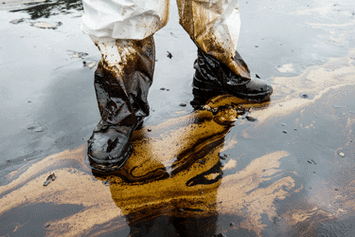Tank trucks roll down the road every day. Companies empty barrels of chemicals on every shift. Farmers handle fertilizer every season. Homeowners use chemicals and compounds for any number of reasons. Some of these materials, so common in everyday life, are classified as hazardous materials. If released in sufficient quantities, these substances pose a hazard to the environment, water supplies, agriculture, flora/fauna, and/or human health.
How Do You Determine If A Substance Is Hazardous Or Not?
Hazardous materials are supposed to have clear labeling on the container in which it is stored. The label is to indicate the kind of material it is and the hazards it poses.
In many situations, though, labeling may be missing or not easy to read. In those cases, it is necessary to check lists of materials to see if a substance is hazardous or not. The EPA and other government agencies keep updated lists of these materials on their websites. Many companies keep hard copies of those lists somewhere on site.
What Are Reportable Quantities When Talking About Hazardous Substances?
The reportable quantities of a hazardous substance is the amount of that substance that has to be released before the EPA requires notification to go to the National Response Center. These quantities are based on volume.
The thresholds for reporting vary widely from one substance to another. For example, if even one pound of arsenic pentoxide is released, it is reportable to the EPA. On the other hand, it takes a release of 5000 pounds of chloral before it is reportable to the EPA. The exact volume of reportable quantities is determined by federal, state, and agency regulations.
If a container of a hazardous material is at the reportable quantity level, the labeling must contain the abbreviation "RQ." If that container is involved with a spill, a report must be made.
What Is The National Response Center?
The National Response Center is the central communication point for anyone reporting the release of a hazardous substance within the United States. The NRC takes reports on everything from oils spills to chemical releases to pipeline releases. Any fatality involving the transportation of hazardous materials is also under the jurisdiction of the NRC. The NRC will get detailed information on the incident and report it to proper federal authorities for action.
If you need help determining the extent of a hazardous waste release, contact Talon/LPE. We are an environmental consulting company helping clients throughout Texas, Oklahoma and New Mexico.
How Do You Determine If A Substance Is Hazardous Or Not?
Hazardous materials are supposed to have clear labeling on the container in which it is stored. The label is to indicate the kind of material it is and the hazards it poses.
In many situations, though, labeling may be missing or not easy to read. In those cases, it is necessary to check lists of materials to see if a substance is hazardous or not. The EPA and other government agencies keep updated lists of these materials on their websites. Many companies keep hard copies of those lists somewhere on site.
What Are Reportable Quantities When Talking About Hazardous Substances?
The reportable quantities of a hazardous substance is the amount of that substance that has to be released before the EPA requires notification to go to the National Response Center. These quantities are based on volume.
The thresholds for reporting vary widely from one substance to another. For example, if even one pound of arsenic pentoxide is released, it is reportable to the EPA. On the other hand, it takes a release of 5000 pounds of chloral before it is reportable to the EPA. The exact volume of reportable quantities is determined by federal, state, and agency regulations.
If a container of a hazardous material is at the reportable quantity level, the labeling must contain the abbreviation "RQ." If that container is involved with a spill, a report must be made.
What Is The National Response Center?
The National Response Center is the central communication point for anyone reporting the release of a hazardous substance within the United States. The NRC takes reports on everything from oils spills to chemical releases to pipeline releases. Any fatality involving the transportation of hazardous materials is also under the jurisdiction of the NRC. The NRC will get detailed information on the incident and report it to proper federal authorities for action.
If you need help determining the extent of a hazardous waste release, contact Talon/LPE. We are an environmental consulting company helping clients throughout Texas, Oklahoma and New Mexico.


